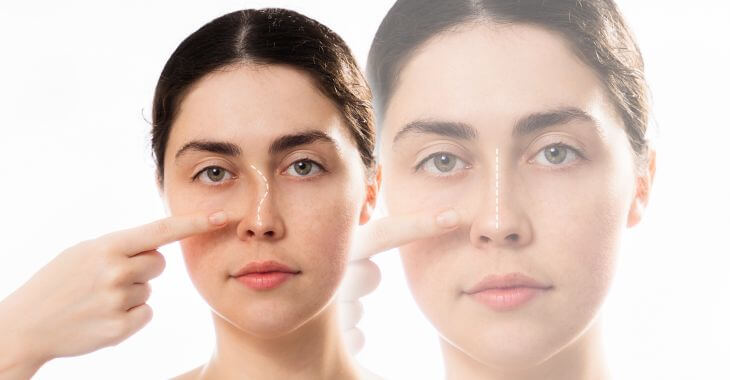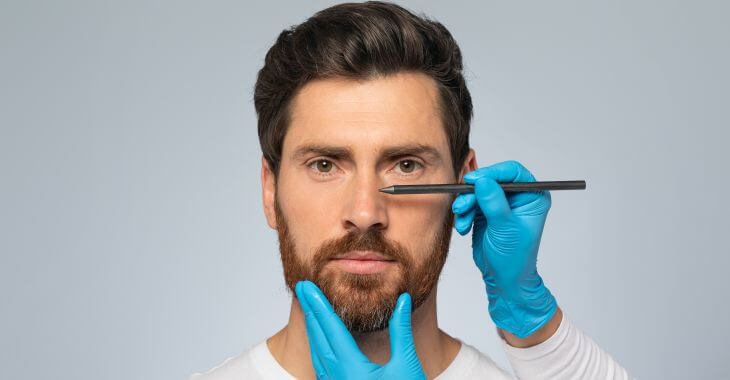Septoplasty vs Rhinoplasty: What Is the Difference?

Septoplasty and rhinoplasty are two distinct surgical procedures aimed at addressing different issues related to the nose. While they both involve nasal surgery, they serve different purposes and target specific nasal problems. Here are some differences when it comes to septoplasty vs rhinoplasty.
What is Septoplasty?
Septoplasty focuses on correcting a deviated septum, the thin wall of cartilage and bone that separates the nasal passages. A deviated septum occurs when this structure is crooked or displaced, often leading to breathing difficulties, congestion, snoring, frequent sinus infections, and sometimes nosebleeds.
Septoplasty aims to straighten and reposition the septum to improve nasal airflow and alleviate associated symptoms. It focuses on improving the function of the nose, improving breathing and reducing risks of conditions such as chronic sinusitis.
During septoplasty, the surgeon typically makes an incision inside the nose and lifts the mucous membrane covering the septum. They then reshape or remove the obstructing bone or cartilage and reposition the septum. This procedure aims to restore proper nasal function vs external appearance.
What is Rhinoplasty?
Rhinoplasty, on the other hand, is a cosmetic procedure aimed at altering the external appearance of the nose. It addresses aesthetic concerns such as a dorsal hump, asymmetry, size, shape or overall proportion of the nose.
While some individuals seek rhinoplasty for cosmetic reasons, others may opt for it due to functional issues like breathing problems or deformities caused by trauma. Rhinoplasty for deviated septum can be performed when both functional and aesthetic changes are desired by the patient.
During rhinoplasty, the surgeon can modify the nasal bone, cartilage, or soft tissue to achieve the desired cosmetic outcome. This may involve reducing or augmenting the nasal bridge, refining the nasal tip, narrowing nostrils, or addressing other aesthetic concerns.
Rhinoplasty can significantly enhance facial harmony and self-confidence by reshaping the external appearance of the nose. It is one of the most requested cosmetic surgeries by all genders due to its enormous impact on the balance and attractiveness of facial features.
Why They Are Performed
Septoplasty is primarily performed to address functional issues related to nasal obstruction caused by a deviated septum. Patients experiencing breathing difficulties, chronic congestion or recurrent sinus infections due to a deviated septum may benefit from septoplasty to improve nasal airflow.
On the other hand, rhinoplasty is performed for cosmetic purposes or to address both aesthetic and functional concerns. Individuals seeking to enhance the appearance of their nose or correct deformities resulting from injury, congenital conditions, or breathing difficulties may opt for rhinoplasty.
For those who have a deviated septum and external aesthetic concerns, septoplasty and rhinoplasty can be performed at the same time. While the deviated septum is addressed, the nose can be reshaped to achieve the desired form, combining two surgeries at once.
Difference Between Septoplasty and Rhinoplasty Recovery
Septoplasty vs rhinoplasty recovery can differ based on the extent of the procedure and individual healing patterns. However, some general differences can be noted between the two nasal surgeries.
Septoplasty Recovery
Patients typically experience mild discomfort, congestion and swelling after septoplasty. Recovery may involve nasal packing or splints for a few days to support the septum as it heals. Improvement in breathing and reduced symptoms may be noticeable shortly after surgery.
Most individuals can resume non-strenuous activities within a week, with full recovery in a few weeks after septoplasty.
Rhinoplasty Recovery
Rhinoplasty may involve more noticeable swelling and bruising, particularly around the eyes and nose. Nasal packing or splints might also be used temporarily. Patients are advised to avoid strenuous activities and protect their noses from injury during the initial stages of recovery.
Complete recovery from rhinoplasty can take several weeks to months, with the final results becoming apparent gradually as swelling subsides. When it comes to septoplasty vs rhinoplasty recovery, rhinoplasty tends to involve a longer healing process as it is usually a more invasive procedure.
Septoplasty vs. Rhinoplasty Surgeons
One major difference between septoplasty and rhinoplasty is who performs these procedures. Septoplasty is a procedure that is usually performed by an ear, nose and throat (ENT) specialist or by a plastic surgeon. It does not require expertise in cosmetic surgery since it only addresses function.
Rhinoplasty is a specialty cosmetic surgery that is best performed by a skilled and experienced plastic surgeon. The procedure often involves reshaping, removing or enhancing the bone and cartilage of the nose to create the desired shape and size.
Both septoplasty and rhinoplasty are intricate procedures that should be performed by experienced surgeons. Consultation with a qualified surgeon is crucial to determine the most suitable procedure based on individual needs, whether for functional improvement or cosmetic enhancement of the nose.

If you have any questions regarding whether a septoplasty or rhinoplasty procedure is right for you, consulting with an ENT specialist or plastic surgeon that offers these procedures is recommended. Keep in mind that plastic surgeons often perform both, while ENT specialists usually only perform septoplasty.
The information provided on this website, including text, graphics, images, and other materials, is intended solely for informational purposes and should not be used as a substitute for professional medical advice, diagnosis, or treatment.




)